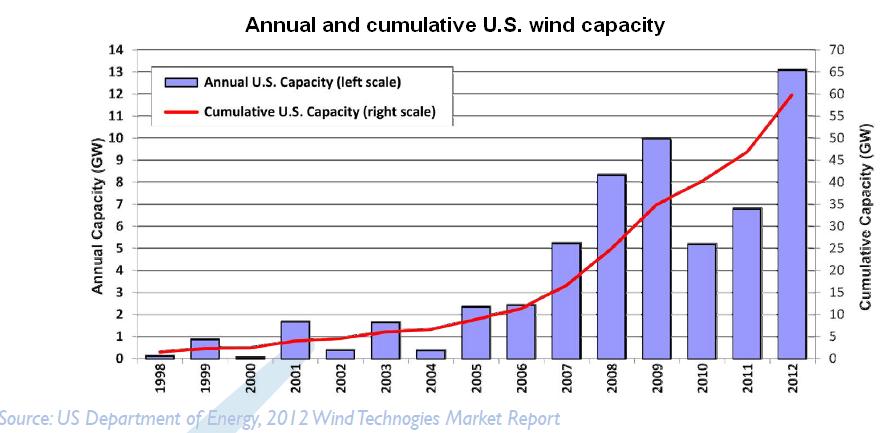Editor’s note: This introduction to an eight-page report has been issued by Renewable Choice Energy. A link to the full report is below.

The graph is for windpower growth in the U.S. But globally, wind power is growing at an annual rate of 30%; there are now more than 200,000 wind turbines worldwide, producing 282 GW of capacity annually with a total annual production of 460 terawatt hours.
It’s been an interesting year for renewable energy. Sensitivity to climate change is at an all-time high thanks to severe weather events such as massive, widespread drought and Hurricane Sandy. Even long-term climate change naysayers have begun to change their tune.
This announcement came on the heels of reports that total U.S. emissions are at their lowest levels since 1994 and are expected to continue to fall as more natural gas and renewable energy comes online over the next several decades.
Thanks to the extension of the Production Tax Credit (PTC) at the end of 2012, we are building new sources of renewable energy at record rates. For example, in January, 100% of the new capacity added to the U.S. electrical grid was from renewable sources3 and renewables accounted for 25% of all new electricity generating capacity installed in the first six months of 2013.
And in June, the President announced the details of his Climate Plan, which includes targets to double renewable energy generation by 2020. The data all points to a promising shift: a perhaps final, push to eliminate our dependence on carbon-based fuels. Any way you look at it, renewables are winning.
A new energy paradigm
The ability to harness energy to generate electricity is arguably one of the most important discoveries made by humankind. Without electricity, there would be no industrial age, and certainly no digital one.
Year over year, global energy demands increase without pause, says the report, and as the global population continues to grow and advance, so will our appetite for energy. Since the Industrial Revolution, we have depended on energy-rich, carbon-based sources of fuel: wood, coal, petroleum, and natural gas have all been widely abundant, reasonably priced, and highly valued for their ability to burn quickly and at temperatures intensive enough to support our demands. However, none of these energy sources is clean. The destruction of carbon-based fuels generates air pollution in the form of gases and particulate and releases climate-damaging greenhouse gases (GHGs) including CO2, methane, and ozone.
These same fuel sources are notoriously dangerous, highly controversial, rigorously controlled by a wealthy few, and the source of tremendous human and planetary suffering. Ultimately, they are finite. While no one knows for sure when we’ll run out of oil, it is generally agreed upon that someday we will.6 As a result, utilities, businesses, and governments around the globe are turning to renewables as a solution to our energy challenges. Renewable energy comes from sources that are readily or continuously replenished, including sunlight, wind, running water, tidal waves, and geothermal heat. The use of renewables is associated with a reduction in GHGs and pollution and an increase in domestic energy reliance and job creation.
Renewables also provide a dependable source of energy to rural and remote areas, where economic prosperity and human development is directly linked to a reliance on electricity; UN Secretary-General Ban Ki-moon has publicly stated that renewables have the power to “lift the poorest nations to new levels of prosperity.”
The demise of fossil fuels and the rise of clean energy
Over the past 15 years, energy generation from cleaner power sources has been steadily increasing at the same time that fossil fuel consumption has been in decline. Natural gas—a cleaner and more affordable fossil fuel—has seen exponential growth, nearly doubling during that period.
Wind and solar power have experienced similar dramatic growth curves. For example, in 1998, total wind power capacity in the U.S. was less than one gigawatt whereas in 2012, annual U.S. wind capacity was closer to 65 GW. Contrast these numbers to coal produced electricity: during a similar period, 2003-2012, coal has dropped from greater than half of all energy production to only 38% of the U.S. power supply.
Filed Under: News




